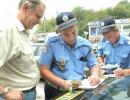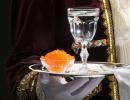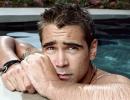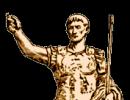Application for the preparatory group on the theme of the animal world. Application “Animals living in the autumn forest”
Anna Gulyaeva
Abstract of GCD in art
creativity(silhouette applique) V preparatory group (teamwork).
,Forest inhabitants,
Tasks:Teach children to create inhabitants of the autumn forest from animal silhouettes, cut out according to self-drawn contours or from paper folded haphazardly. Form, compose, place forest inhabitants in autumn forest .
Preliminary work. Looking at illustrations depicting autumn forests, with images of animals and birds living in the forest,listening to discs with recordings of birds singing in the forest. Drawing animals and birds with a simple pencil. Creating a composition, Autumn Forest, made with wax crayons.
Materials:Finished composition, Autumn forest, sheets of colored paper, glue, glue brushes, napkins, pencils, erasers. Prepared animal silhouettes we will bring up for display, scissors.
Progress of the lesson: Guys, how beautiful the forest is autumn time year! What a riot of colors prevails there! Listen to an excerpt from poems I. Bunina, Listopad,
The forest is like a painted tower,
Lilac, gold, crimson,
Standing above a sunny meadow,
Fascinated by the silence.
In the last lesson, we drew an autumn forest. I think that our forest turned out wonderful, but looking at it it becomes somehow sad, it is somehow empty, but why?
Children's answers.
That's right there isn't forest inhabitants,T. e animals and birds. So who do we live there? Guess the riddles and you will find out.
The clubfooted giant
To avoid falling into a trap,
Sleeps all winter long,
He sucks his paw sweetly. (bear)
He looks like a sheep
Every tooth is a sharp knife!
He runs, grinning his mouth,
Ready to attack a sheep. (wolf)
What a dangerous beast
In a beautiful fur coat
It penetrates into the yard,
There are plenty of chickens there. (fox)
What kind of forest animal is this?
Stood up like a post under a pine tree
And stands among the grass -
The ears are larger than the head. (hare)
Flies all night -
Gets mice
And it will become light
Flies to sleep in a hollow. (owl)
Who heals the trees in the forest,
Without sparing his head? His work is hard -
He's been hammering trunks all day. (woodpecker)
And others. (with each answer I display animal figures on a flannelgraph).
Now each of you will choose one of the animals and try to draw it silhouette on back side colored paper and cut it out, or you can also fold the paper into pieces, draw an animal or bird and cut it out too.
Children choose the color of paper for a given animal and get to work.
Once the figures are ready, we glue them into our autumn forest, placing them correctly, each animal or bird has its own place.
We hang up the finished work to show parents.
Summary of an open show on a collective plot application on the theme: “Meetings in the winter forest” with children 6–7 years old.
Target: Strengthen the ability to work with paper and glue, create a single holistic composition.
Tasks:
1. Strengthen the skills of symmetrical cutting, cutting along the contour, tearing and gluing paper.
2. Develop children's creativity, artistic taste, and imagination when creating a composition.
3. Develop the ability to care for animals and flora.
4. Foster the desire to bring joy to yourself and others from quality work.
5. Develop vocabulary (the ability to form possessive adjectives).
Methodical techniques: Verbal games, Plastic exercises - games. Explanation, repetition, reminder, demonstration.
Questions:
What animals live in the forest?
What animals cannot be found in the forest in winter?
Who would you like to cut and paste?
Assessment - analysis.
Material and equipment:
Demo: easels with reproductions of paintings, didactic plots, figurines of animals, a model of a forest. Disc with a recording of P.I. Tchaikovsky “The Seasons. Winter".
Dispensing: tables in a ribbon order, colored paper, glue, scissors, napkins, oilcloths - plates, brushes, stands, large cardboard sheets with a winter forest partially drawn by children.
Disc with a recording of P.I. Tchaikovsky “The Seasons. Winter."
Previous work:
1. Reading the works of Russian writers about animals (E. Charushin, V. Bianki, G. Skrebitsky, M. Prishvin) and their illustrations for their works. Introducing a new word for children: animal artists.
2. Modeling of animals.
3. Drawing animals.
4. Plot - role-playing game"Help to foresters and
Progress of the lesson:
The teacher attracts the attention of the children by showing them a ready-made script for a jointly composed fairy tale.
Tells them that they have learned a lot about the animal world, about the life of animals in winter time, read a lot, drew, sculpted. The teacher asks, could the children write a fairy tale about the life of animals in the forest and stage a play based on this fairy tale?
What do we have for this? (animal figures)
Motivation: Helping an adult and personal interest.

But we are missing something for the performance. What do you think? Correct background, scenery. Leads children to what can serve as scenery for a play. Children give advice, suggestions, and come to the consensus that cardboard sheets are very convenient, they can be placed as a screen on a distant or side background, and the middle of the table can be used for playing with toys - actors. The teacher asks what can be depicted from paper on our decorations? Correct: trees, bushes, snow, animals, birds.
But before doing all this, you need to remember the habits of animals and give them a verbal description.
The teacher suggests conducting a plastic sketch (show who is small and who is big, large).
Conducts a word game (selection of synonyms).
A game:“Draw this or that animal.”
A game:“Describe the animal.”
Preparing for work:

The teacher reminds us that yesterday the children drew animals using stencils and asked why we are drawing, what answer did you hear? That's right, there will be a surprise. Now the time for a surprise has come. He invites you to go to the table and find your work, pick up paper for trees and bushes. Children select materials and go to their work places. The teacher says that our work is collective, we can help each other, consult, and allows us to do the work while sitting or standing, whatever is convenient.
Independent activities:




While doing the work, the teacher gives practical advice, reminds, if necessary, about safety precautions, provides assistance, showing this or that cutting technique, but on his own sheet of paper. While the children are busy working, music plays. P.I. Tchaikovsky “Seasons. Winter".
The teacher reads quatrains from time to time, looking at the children’s animals.
1. The squirrel has squirrel ears,
Fluffy squirrel tail,
Elegant squirrel fur coat
And very short.
2. The wolf has a wolf tail
And a gray wolf fur coat
The wolf is a very dangerous guest:
The wolf's teeth are too sharp.
3. The tail of the little fox is fox,
Soft fox paws
Just don't trust her redhead
All her thoughts are insidious.
4. Hare long ears
A hare in the forest needs:
If you listen carefully;
Wolves are not that scary.
5. Moose have a moose tail
Branched elk antlers,
Elk tall,
Moose eyes are radiant.
The teacher suggests decorating their work with “snow” by finely tearing and gluing white paper.
He asks where the snow might be? Confirms; on branches, on the ground, falling, spinning in the air. It reminds you that snowflakes in the air are smaller, which means the pieces of paper should be smaller.
The teacher suggests finishing the work. Those children who have finished put their work on the table and help those who have not finished yet.
Surprise moment:
The teacher calls the children to him, drawing them away from children's work, standing with his back to them, asks if they would like to go into the snowy forest. To do this you need to “put on your ski suits”, “get on your skis”. Meanwhile, the assistant covers the soft modules with white padding polyester, depicting snowdrifts near the table where the children’s work is located.
Analysis of work and exit to further activities:


Children sit on “drifts” and analysis is carried out. The authors of the works talk about their animals.
Having finished the analysis and praising the creators of the scenery, the teacher asks what task is now before them? Right! Compose a fairy tale, write a script, learn a play, act it out and show it to children of younger groups.
Municipal budgetary preschool educational institution
"Kindergarten No. 202 City of Miracles" in the city of Cheboksary, Chuvash Republic
Abstract
Organized educational activities
Educational field "Artistic and aesthetic development"
Modeling of animals according to the plan “Who lives in the forest?”
Prepared by the teacher
Akhmeeva Natalia Anatolyevna
Cheboksary
2018
Topic: Who lives in the forest?
Program content
Target: continue to introduce children to the techniques of sculpting animals in motion.
Tasks:
Educational:
- teach children to plan their work: conceive an image, divide the material into the required number of parts of different sizes, convey the shape and proportional relationship of the parts;
- strengthen children's ability to solve riddles;
- arouse interest in the life of wild animals.
Educational:
- develop creative imagination, emotional responsiveness;
- develop fine motor skills of the hands.
Speech:
- activate the dictionary on the topic “Wild animals of our forest”: little hare, fluffy, stubby (tail), cautious, cheat, etc.
Educational:
- cultivate perseverance and interest in modeling.
Technical:
- teach children to sculpt animals in motion in a constructive way, using existing skills and abilities to work with dough - rolling, flattening, dividing the whole into parts using stacks, teach to combine sculpted parts into one whole, connect them tightly by smearing one part to another and smooth out the boundaries connection of parts;
- to develop in children the ability to convey details in modeling, to show techniques for decorating a sculpted figure with additional elements.
Material and equipment:
- Salt dough (multi-colored),
- Modeling board,
- stack,
- Silhouettes of wild animals,
- Beads,
- Forest composition of plastic trees.
Previous work:
- Reading Russian folk tales;
- Examination of illustrations;
- Reading stories about the life of animals in our forests;
- Conversations about the features of their body covering (fur, spines);
- Rolling out dough into columns.
Methodical techniques:
- Traveling to the forest by bus
- Riddles about animals
- Physical education minute. Finger gymnastics
- Practical part: explanation of animal sculpting techniques
- Independent activity for children: sculpting an animal according to design
GCD move:
- Invitation to travel
Educator: Attention! Attention! Those wishing to take a fascinating journey into the animal world, please take your seats! The bus is leaving! Where? Guess what. Guess the riddle and find out where the funny bus will take us today.
- This city is not simple, it is dense and dense (Forest)
Educator: Yes, today we will go with you to the forest. Who can we meet there? But listen to who the poet Nikolai Rubtsov met there.
A hare ran through the meadow into the forest.
I was walking home from the forest -
Poor frightened hare
So he sat down in front of me,
So he died, stupid,
But, of course, at that very moment
Jumped into the pine forest,
Hearing my cheerful cry.
And probably for a long time
With eternal trembling in silence
I thought somewhere under the tree
About yourself and me.
I thought, sighing sadly,
What friends does he have?
After Grandfather Mazai
There is no one left.
- Who did the poet meet in the forest?
- What happened to the hare when he saw the poet?
- What is the hare in Nikolai Rubtsov's poem?
Educator: Guys, while we were talking, our bus drove up to the forest. I suggest you come to the table.(There is a forest on the table).Who do you think we will meet here? Guess the riddle.
- Jumps through the forest - hides his ears, stands up like a pillar - his ears stick up" (Hare)
The teacher demonstrates a pre-fashioned hare.
- Why does a hare have white fur?
- Why did he change the color of his fur coat?
Educator: You can make a hare in different ways: it can be a small, touching bunny that got lost, or a frivolous hare, Boast, a hare offended by an insidious fox. In all fairy tales, the hare is bullied, so we will sculpt a hare that can run fast. The back of a running hare is arched, the legs are widely spaced, the head is turned forward, the ears are slightly pressed to the head, and the tail is to the body.
- Physical education minute.
It's cold for the bunny to sit
The bunny is hungry to sit
Need to warm up my paws.
Paws up, paws down,
Pull yourself up onto your toes.
We put our paws on the side,
On your toes, hop-hop-hop!
And then squat down,
So that your paws don't get cold.
- Look what -
Everything burns like gold.
Walks around in a fur coat dear,
The tail is fluffy and large. (Fox)
Educator: In order to mold the body, we roll out a thick cylinder, slightly flatten it, and cut it on both sides. Then we bend it in an arc. The body is ready. Apply the tail and muzzle. It turns out this is a fox. This craft is very plastic. By changing the position of the legs, we can make the fox walk or sit. You can decorate the fox with additional small details.
- Under the moon, in cold winter,
A hungry gray beast is prowling,
From the bushes with your teeth - click!
Beware - it's... (wolf)
Educator: The head, tail and body are done in exactly the same way. You can not only put the wolf on its legs, but also sit it down. Or, by changing the position of the paws, make him “run”. Making a wolf from dough this way is also easy. Using these sculpting methods as a basis, you can sculpt not only a wolf, but also many other animals.
- The shaggy grandfather walks -
Thick-footed, club-footed -
He loves raspberries with honey
And he sleeps in the den for six months. (Bear)
- Black-eyed - clattering.
Wears tassels on his ears,
Jumps along the branches like a light
And he hides nuts in the hollow. (Squirrel)
Educator: But the squirrel’s body is made of a figure consisting of half a circle and half an oval, this figure is called an ovoid. The head is made in the form of a small ball, slightly pointed at one end. Decorate the chest with a white cake, make two cheeks, add a black nose. To get the legs, roll two small orange sausages. Use a spatula to mark the fingers; on the top of the head – ears made of small orange triangles with brown tassels at the ends. Be sure to treat the squirrel with a porcini mushroom.
Educator: So you and I visited the forest and learned a lot of interesting things. Let's depict the animals we met in memory of our unforgettable journey.
- Practical part
The children are seated at the tables.
Educator: Let's think about how many parts you need to divide a piece of dough into to make a running hare.
- See if all the parts are the same size? (No)
Stages of work execution.
1. Torso
- The piece from which we will sculpt the body and legs is the largest.
We mark half of the piece with a stack, and then we divide one half in half again and cut it with a stack.
2. Head
- We divide this cut piece into two equal parts: from one part we make a head: we roll out the dough in a circular motion into the shape of a ball and flatten it slightly on one side.
3. Ears and tail
- And from the other part we sculpt ears - long, pointed at the tips. The ears are made by rolling out a “sausage”, and the tail is stubby, short and round. For the tail, take the smallest piece of dough and roll out a small ball. Then these parts are attached to the head and torso.
- It's me, the trickster bunny! Do you know where my fluffy fur coat went? I'm completely cold!
Educator: What should we do guys? How to help a bunny? (Children's answers)
The teacher takes the stick and scratches short strokes on its back, as if drawing fur. Children draw fur on their bunnies.
Educator: Now we will all check together whether we managed to prepare the material for modeling well:
- Show us what we will sculpt the body and legs from?
- Find material for the head.
- What will come out of the remaining piece? (tail and ears). You will divide this piece into parts yourself, and figure out how best to sculpt the tail and long ears.
- Where should we start sculpting a hare? (From the body and legs). Roll out a piece of dough with circular movements of your palms to form a ball, then with straight movements roll out the dough into the shape of an oval or cylinder.
The teacher makes a column, and it is given a certain position.
Educator: The ends of the column lowered down are cut with a stack, moved apart and smoothed, then the remaining parts are attached.
- Independent activities of children
By observing the children’s work, the teacher helps them achieve an expressive representation of the animal’s image.
- Finger gymnastics.
Alternately connecting all fingers with the thumb, starting with the index finger and ending with the little finger. In the opposite direction from the little finger to the index finger. First, the child connects the fingers of one hand, then the other (on stressed syllables).
- Hedgehog, bear, badger, raccoon
They sleep in winter every year (change of hands).
- Wolf, hare, lynx, fox
You will find it in the forest in winter.
Educator: We need to go back to kindergarten.
- Final part
Educator: Well done! Now our animals will not freeze, they have warm fur coats, beautiful eyes and they can run fast. And we will put them in the forest.
- Where were you and me and what did we do?
List of used literature
- Fun plasticine. Learning to sculpt / artist O.S. Moskovka. – M.: Flamingo, 2014.
- Raising and teaching children in the senior group of kindergarten / ed. V. V. Gerbova, T. S. Komarova. – M.: Mosaika-Sintez, 2006.
- Kazakova, T. G. Classes with preschoolers in visual arts / T. G. Kazakova. – M.: Education, 1996.
- Kazakova, T. G. Develop creativity in preschoolers: a manual for kindergarten teachers / T. G. Kazakova. – M.: Education, 1995.
- Komarova, T. S. Visual arts classes in the senior group of kindergarten: lesson notes / T. S. Komarova. – M.: Mosaika-Sintez, 2008.
- Komarova, T.S. Visual activities in kindergarten: programs and guidelines/ T.S. Komarova. – M.: Mosaika-Sintez, 2006.
- Tomilova, S. D. A complete reader for preschoolers with methodological tips. In 2 books / S. D. Tomilova. M.: AST, 2013.
- Khananova, I. Salty dough: fantasies made from flour, salt and water / I. Khananova. – M.: AST-Press, 2012.
Direct educational activities in the preparatory school group. Collective application “Animals in the forest”.
Goal: - develop compositional skills - place animal silhouettes in a panorama winter forest; develop an eye and accuracy;
- to cultivate an aesthetic attitude towards nature; interest in knowledge of nature and a more subtle reflection of impressions in fine art; confidence in your skills;
- teach children to create a plot composition from silhouettes of wild animals, cut out according to a self-circulated template. Introduce the concept of silhouette; learn to use new materials (threads, cotton wool) in your work; support personal creativity.
Materials and equipment: unfinished composition “Winter Forest”, white sheets of paper, templates of wild animals, scissors, glue, pencils, cotton wool, colored threads, napkins - cloth, oilcloth, toys - bear, squirrel, hare, fox, wolf, paintings depicting Russian nature.
Download abstract
Preliminary work: creating the composition “Winter Forest”, talking about wild animals, looking at illustrations in books and magazines; did. games: “Name it correctly”, “Draw an animal”, “Who lives where”.
Educator: guys, tell me, what country do we live in? (Children: in Russia). That's right, in Russia. Our country is large and beautiful, the fields of Russia are wide, the rivers and lakes are deep, the forests of Russia are thick. (As the story progresses, pictures depicting the nature of Russia are displayed). There are many animals in the forests of our country. Name them. (Children's answers). Well done! Diverse animal world our country. Now I’ll tell you riddles, and you name the animals in question.
In the summer he wanders without a path between the pines and birches,
And in winter he sleeps in a den, hiding his nose from the frost. (Bear).
Straight from the tree to the stump
The red light jumped.
And then onto the alder trunk
He jumped up with a dashing jump. (Squirrel).
When I'm hungry, don't meet me
I’ll click my teeth and eat it casually. (Wolf).
Guess what kind of hat?
Furs - a whole armful,
The hat is running in the forest,
It gnaws the bark of the trunks. (Hare).
Look what it's like
Everything burns like gold
Walks around in a fur coat dear,
The tail is fluffy and large.
She's a master at subterfuge.
What is her name? (Fox).
As the riddles are solved, the corresponding animals appear from the basket, and each of them is examined and discussed.
Educator: guys, I suggest you choose and make any animal and place it in our winter forest. To do this, you have pictures on your tables - silhouettes. You must apply glue to this silhouette, and then fill the silhouette with finely chopped threads or cotton wool. And you will end up with an animal with fluffy fur. All that remains is to make the nose, eyes and mouth and “place” the animal in the forest. But before that, we'll play a little.
Physical examination is carried out. minute “Funny Animals”:
The bunny jumps through the bushes, They jump on two legs, making “ears”
Through the swamp and over the hummocks. from the palms.
The squirrel jumps on the branches, They jump with their arms bent in front of their chest.
The mushroom is carried to baby squirrels.
A bear with a clubfoot is walking, They are waddling.
He has crooked paws.
Without paths, without paths They move in a half-squat, making
Rolling prickly hedgehog. round backs.
Children sit at tables and each make their own animal, then glue it onto the winter forest composition.
Educator: guys, look how beautiful we have turned out! Our forest came to life, as if someone had worked a magic wand here! Well done to you!
SVETLANA KAPRININA
Berezkovsky kindergarten
Teacher Kaprinina Svetlana Evgenievna
Application« Animals, living in the autumn forest» .
Program content: to develop children's creative imagination, to connect the content with the images depicted in the drawing, to select leaves in such a way as to obtain different animals, instill in children interest in the environment, develop observation skills.
Material: autumn leaves, dried and prepared in advance for work, a sheet of paper, glue, brush.
Preliminary work: a walk into a forest plantation, observing changes occurring in nature, collecting leaves of different shapes and colors, and preparing a herbarium from the collected leaves.
Methodology classes: the teacher shows drawings with leaf appliques. Invites everyone to try folding the prepared leaves animal which he liked the most. The teacher explains what animals live in the forest, remembers how life changes in forest during autumn, explains changes in life animals(it became cold, hungry).
You can use artwork.
Meeting autumn.
Here are the squirrel and the bunny,
Prickly hedgehog, brown bear.
Now we will ask them to say
How they all meet autumn.
It's time for me, the bunny, to molt,
It's time for me to change my fur coat.
I can't be gray in winter -
They'll spot me in the snow.
And I'm in a hurry, I'm in a hurry, I'm in a hurry,
I dry mushrooms on twigs.
I'm stocking up on nuts.
That's how I try! Good morning!
I'll soon go to bed in the den,
Behind autumn winter again.
Let me dream about honey,
I'll wake up when spring comes.
I, too, will sleep like a bear.
I hunted for the summer:
I looked for mushrooms and caught mice.
I need to rest for this
I was tired, exhausted.
I'll bring myself some twigs,
I'll make an apartment in forest, I'll wake up -
I'm going to celebrate spring
I'm hunting again, let's start!
After this, each child sticks the previously collected animal from autumn leaves . Finished works from appliqués placed on the stand.





Publications on the topic:
Lesson on speech development “Who lives in the autumn forest” Program content: Continue to teach children to write a descriptive story about animals using diagrams. Improve coordination skills.
Lesson summary “Walk in the autumn forest” Organizational component Vosp: Today, guys, I want to talk to you about what happens in the forest in the fall, about how they prepare for winter.
Autumn is a wonderful golden time. If you look at the forest, it seems that it contains all the colors that exist in the world. Miraculous phenomenon- leaf fall.
After a hot summer, the children of the older groups have grown noticeably and matured. The set of children is very interesting. He's not a child, he's an artist! Wish.
Summary of the logorhythmic lesson “In the autumn forest” Children enter the hall to the autumn melody and sit down. 1. Organizational moment. Presenter: Along the gilded road, autumn has already come to us, And to our own.
Abstract of the educational activity “Teremok in the autumn forest” Municipal Autonomous Preschool Educational institution Kindergarten combined Type No. 7 “Fairy Tale” GCD Compiled by: Educator:.
Logorimic lesson “In the autumn forest” Logorhythmic lesson on the topic “Berries and mushrooms”. Theme of the lesson: “In the autumn forest.” Non-speech goals: - development of coordination of movements, orientation.






